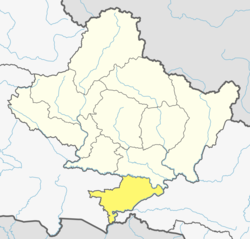Nawalpur (/nəˌwʌlˈpʊər/, Nepali: नवलपुर, pronounced [ˈnʌwʌlpur]) is one of 11 districts of Gandaki Province of Nepal. The headquarters of the district is Kawasoti.[1]
Nawalpur District
नवलपुर | |
|---|---|
 Shashwat Dham, Devachuli | |
 Location of Nawalpur (dark yellow) in Gandaki Province | |
 Divisions of Nawalpur | |
| Coordinates: 27°19′N 83°24′E / 27.32°N 83.40°E | |
| Country | |
| Province | Gandaki Province |
| Established | during Rana regime |
| Disestablished | 1962 |
| Reestablished | 2015 |
| Admin HQ. | Kawasoti |
| Government | |
| • Type | Coordination committee |
| • Body | DCC, Nawalpur |
| Area | |
| • Total | 1,331.16 km2 (513.96 sq mi) |
| Population | |
| • Total | 310,864 |
| • Density | 230/km2 (600/sq mi) |
| Time zone | UTC+05:45 (NPT) |
| Website | www |
Nawalpur District and Parasi District were formerly a single district, Nawalparasi District, until a reorganization effective 20 September 2015.
The total area of Nawalpur District is 1,331.16 square kilometres (513.96 sq mi) and total population of this district as of 2011 Nepal census is 310864 individuals.[2]
History
editDuring Rana regime, Nawalpur district was a sub-district of Chitwan District then it established separately and again merged with a small portion (Parasi) of Butwal District and established Nawalparasi District. In 2015 again Nawalpur District was again separately reestablished.
Divisions
editThe district is divided into four urban municipalities and four rural municipalities.[2][3]
Urban municipalities
edit- Kawasoti Municipality (Headquarters)
- Gaindakot Municipality
- Devachuli
- Madhyabindu
Rural municipalities
editDemographics
edit| Census year | Pop. | ±% p.a. | |
|---|---|---|---|
| 1981 | 149,543 | — | |
| 1991 | 211,228 | +3.51% | |
| 2001 | 272,557 | +2.58% | |
| 2011 | 311,604 | +1.35% | |
| 2021 | 381,105 | +2.03% | |
| |||
| Source: Citypopulation[4] | |||
At the time of the 2011 Nepal census, Nawalpur District had a population of 311,604.
As their first language, 55.3% spoke Nepali, 25.2% Magar, 11.0% Tharu, 1.9% Gurung, 1.6% Newari, 1.2% Bhojpuri, 0.8% Tamang, 0.7% Kumhali, 0.5% Bote, 0.4% Khash, 0.4% Maithili, 0.3% Darai, 0.2% Hindi, 0.1% Bhujel, 0.1% Majhi, 0.1% Urdu and 0.1% other languages.[5]
Ethnicity/caste: 29.1% were Magar, 23.8% Hill Brahmin, 11.8% Tharu, 7.7% Chhetri, 5.4% Kami, 3.9% Kumal, 2.9% Gurung, 2.9% Newar, 2.5% Damai/Dholi, 1.8% Thakuri, 1.4% Tamang, 1.0% Sarki, 0.8% other Dalit, 0.7% Bote, 0.6% Darai, 0.6% Sanyasi/Dasnami, 0.5% Musalman, 0.4% Gharti/Bhujel, 0.3% Musahar, 0.2% Badi, 0.2% Kathabaniyan, 0.2% Rai, 0.1% Koiri/Kushwaha, 0.1% Kurmi, 0.1% Majhi, 0.1% Mallaha, 0.1% Sunuwar, 0.1% Teli, 0.1% other Terai, 0.1% Yadav and 0.2% others.[6]
Religion: 87.8% were Hindu, 8.7% Buddhist, 2.7% Christian, 0.5% Muslim, 0.1% Prakriti and 0.1% others.[7]
Literacy: 74.7% could read and write, 2.1% could only read and 23.1% could neither read nor write.[8]
See also
editReferences
edit- ^ "पूर्वी नवलपरासीको नाम 'नवलपुर जिल्ला' र सदरमुकाम कावासोतीमा राख्ने निर्णय" [Decision to named Nawalpur of the East Nawalparasi and fix Headquarter at Kawasoti]. www.kantipurdaily.com (in Nepali). KMG. 22 September 2017. Retrieved 21 March 2018.
- ^ a b "CITY POPULATION– statistics, maps & charts". www.citypopulation.de. 8 October 2017. Retrieved 21 March 2018.
- ^ "District Corrected Last for RAJAPATRA (page no. 261)" (PDF). www.mofald.gov.np. Retrieved 2 March 2018.
- ^ "NEPAL: Administrative Division". www.citypopulation.de.
- ^ NepalMap Language
- ^ NepalMap Caste
- ^ NepalMap Religion
- ^ NepalMap Literacy